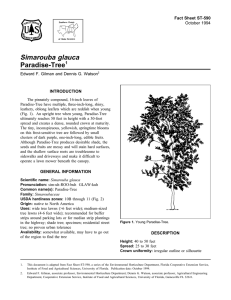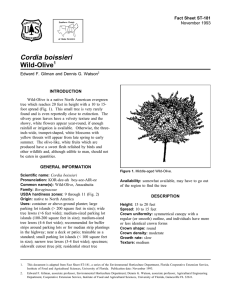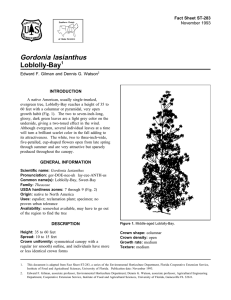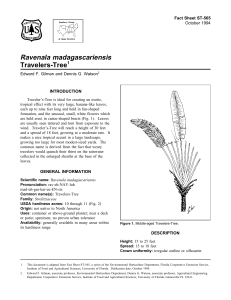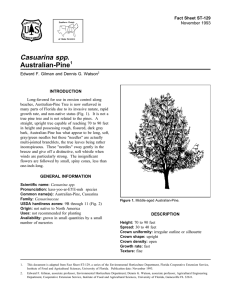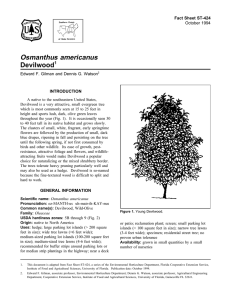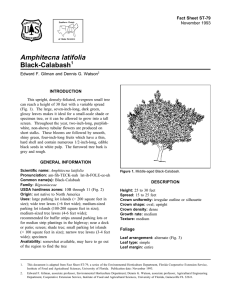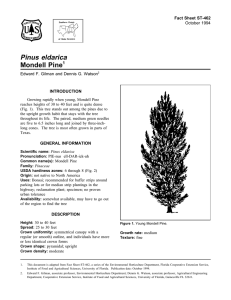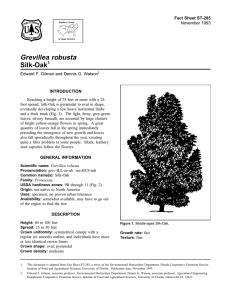Coccothrinax argentata Silverpalm Fact Sheet ST-176 1
advertisement
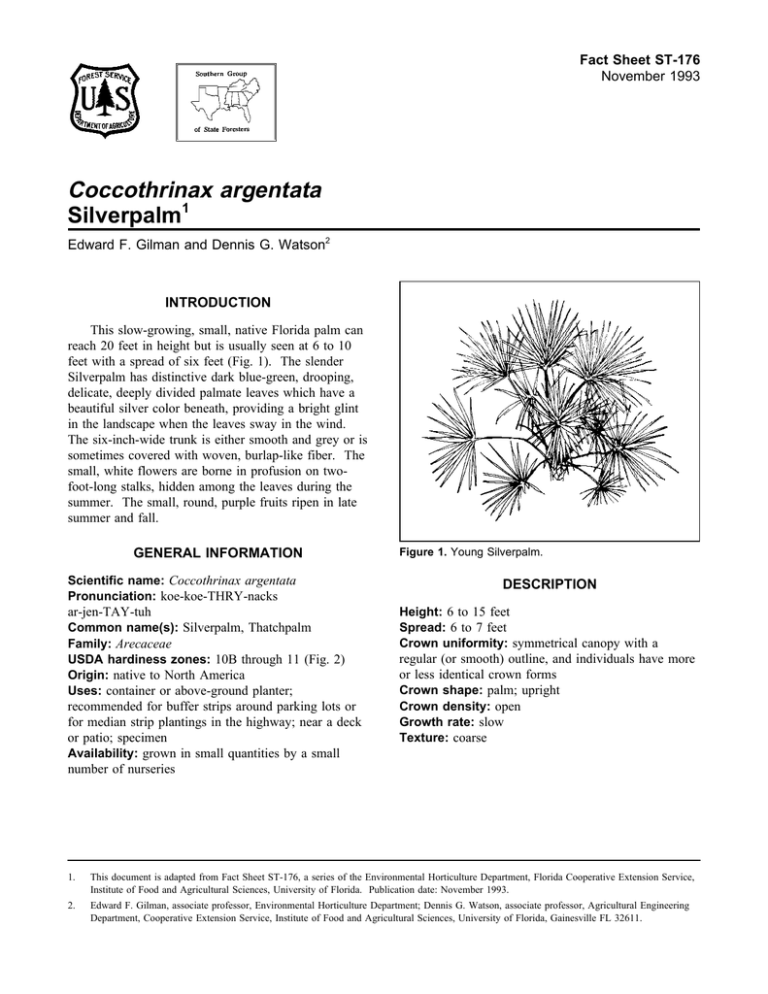
Fact Sheet ST-176 November 1993 Coccothrinax argentata Silverpalm1 Edward F. Gilman and Dennis G. Watson2 INTRODUCTION This slow-growing, small, native Florida palm can reach 20 feet in height but is usually seen at 6 to 10 feet with a spread of six feet (Fig. 1). The slender Silverpalm has distinctive dark blue-green, drooping, delicate, deeply divided palmate leaves which have a beautiful silver color beneath, providing a bright glint in the landscape when the leaves sway in the wind. The six-inch-wide trunk is either smooth and grey or is sometimes covered with woven, burlap-like fiber. The small, white flowers are borne in profusion on twofoot-long stalks, hidden among the leaves during the summer. The small, round, purple fruits ripen in late summer and fall. GENERAL INFORMATION Scientific name: Coccothrinax argentata Pronunciation: koe-koe-THRY-nacks ar-jen-TAY-tuh Common name(s): Silverpalm, Thatchpalm Family: Arecaceae USDA hardiness zones: 10B through 11 (Fig. 2) Origin: native to North America Uses: container or above-ground planter; recommended for buffer strips around parking lots or for median strip plantings in the highway; near a deck or patio; specimen Availability: grown in small quantities by a small number of nurseries Figure 1. Young Silverpalm. DESCRIPTION Height: 6 to 15 feet Spread: 6 to 7 feet Crown uniformity: symmetrical canopy with a regular (or smooth) outline, and individuals have more or less identical crown forms Crown shape: palm; upright Crown density: open Growth rate: slow Texture: coarse 1. This document is adapted from Fact Sheet ST-176, a series of the Environmental Horticulture Department, Florida Cooperative Extension Service, Institute of Food and Agricultural Sciences, University of Florida. Publication date: November 1993. 2. Edward F. Gilman, associate professor, Environmental Horticulture Department; Dennis G. Watson, associate professor, Agricultural Engineering Department, Cooperative Extension Service, Institute of Food and Agricultural Sciences, University of Florida, Gainesville FL 32611. Coccothrinax argentata -- Silverpalm Page 2 Figure 2. Shaded area represents potential planting range. Foliage Leaf Leaf Leaf Leaf Leaf Leaf arrangement: spiral (Fig. 3) type: simple margin: entire shape: star-shaped venation: palmate type and persistence: broadleaf evergreen; Fruit characteristics: does not attract wildlife; inconspicuous and not showy; no significant litter problem Trunk and Branches evergreen Leaf blade length: 18 to 36 inches Leaf color: blue or blue-green; green; silver Fall color: no fall color change Fall characteristic: not showy Trunk/bark/branches: grow mostly upright and will not droop; not particularly showy; should be grown with a single leader; no thorns Pruning requirement: needs little pruning to develop a strong structure Breakage: resistant Crown shaft: no Flower Culture Flower color: white Flower characteristics: inconspicuous and not Light requirement: tree grows in part shade/part sun; showy; summer flowering Fruit Fruit Fruit Fruit Fruit shape: round length: < .5 inch covering: fleshy color: purple tree grows in the shade; tree grows in full sun Soil tolerances: clay; loam; sand; acidic; alkaline; well-drained Drought tolerance: high Aerosol salt tolerance: high Coccothrinax argentata -- Silverpalm Page 3 Pests and Diseases No pests or diseases are of major concern. Figure 3. Foliage of Silverpalm. Other Roots: surface roots are usually not a problem Winter interest: no special winter interest Outstanding tree: not particularly outstanding Invasive potential: little, if any, potential at this time Verticillium wilt susceptibility: not known to be susceptible Pest resistance: no pests are normally seen on the tree USE AND MANAGEMENT This palm is most suited for residential and commercial landscapes were the unusual blue foliage can be appreciated. It makes a nice accent in a shrub border, and can be massed together to create a dramatic colorful impact. Place it in a low-growing groundcover to provide an exclamation point in the landscape. Growing in full sun or partial shade, Silverpalm will tolerate any well-drained soil. The palm will grow straight up and provide a beautiful blue accent, even in areas receiving only two or three hours of sun. It is highly salt-tolerant and is especially useful for coastal locations and for soils with a high pH. Propagation is by seed.

